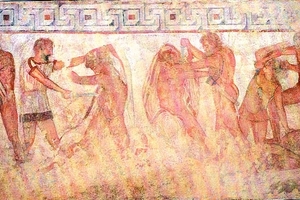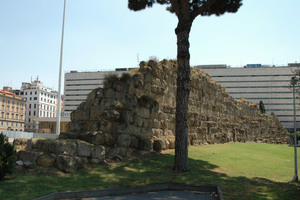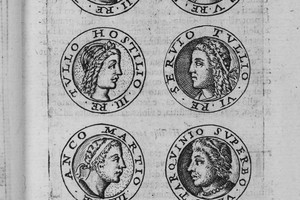Servius Tullius
According to tradition, Servius Tullius is considered the sixth king of Rome, who supposedly reigned from 578 to 535 BCE. His image is presented to us as one of the most historically grounded among the early Roman kings. There are two legends about his origins. The first and most commonly accepted version is conveyed by Dionysius of Halicarnassus in his work Roman Antiquities. The second version comes from Emperor Claudius, who was regarded as an expert on Etruscan history and recounted it in one of his speeches in the Senate.
Let’s first consider the version by Dionysius of Halicarnassus. According to this account, Servius Tullius was the son of a noblewoman from the city of Corniculum. When the Romans captured the city, she was taken captive. The boy was raised in the household of Tarquinius, the previous king of Rome. According to tradition, the child was surrounded by love and held in high regard by the Roman people and the Senate. Tarquinius married him to his daughter, and after the king's death, Servius Tullius seized power and became king. This is the commonly accepted tradition regarding the origin of the king. The second version about the origin of this Roman king is provided by Emperor Claudius. It significantly differs from the first. The emperor claims that Servius Tullius was an Etruscan adventurer named Mastarna, who infiltrated Rome, changed his name, and usurped power. An artistic depiction of Claudius' version can be seen in the fresco from the François Tomb.
From all of the above, it can be concluded that the two versions of the legend differ significantly. Modern scholars do not deny the historicity of Servius Tullius, but this does not necessarily mean that the legends surrounding the king's origins have a real historical basis. The majority of classical scholars lean towards the real existence of Servius Tullius, primarily due to his role as a reformer. He is credited with a number of significant reforms that laid the foundation for the Roman state and political system. During his reign, the following innovations were implemented:
1. Division of Rome’s territory into territorial tribes: People were now registered in rural districts and urban areas. The exact number of tribes is unknown. Current researchers believe there were 17 rural and 4 urban tribes. To be considered a citizen, one had to be registered in one of these tribes.
2. Division of the population into 5 property-based classes: People who did not fit into any class due to lack of wealth were called proletarii. They were citizens but without property.
3. Introduction of wealth measurement by the copper coin as: However, this might be inaccurate. According to Belkin M.V., the property qualification was not introduced before the 4th-3rd centuries BCE. Initially, wealth was measured by land.
4. Military service based on property: The wealthiest citizens of the first class served in the cavalry, while others served in the infantry, fully equipped as heavy infantrymen. Citizens of other classes also served in the infantry, with poorer citizens having less equipment. The proletarii were exempt from military service. Each class was required to provide a certain number of centuriae. The first class had to provide 80 centuriae of infantry and 18 cavalry. The other classes provided significantly fewer, totaling around 193 centuriae.
5. Creation of a new type of popular assembly, the comitia centuriata (centuriate assembly): Based on the class division of society, the first class held the greatest influence.
6. Tradition attributes the construction of Rome’s first city wall to Servius Tullius, a section of which can still be seen today.
This is the information we have regarding the reforms of Servius Tullius. Naturally, not all of it is reliable. There are disagreements about the determination of citizens' property status. The clear division of Roman society into classes is also questioned. Kovalev S.I. suggests that initially all citizens were divided into two categories: classis and infra classem. The division of the state into tribes has clear similarities with the reforms of Cleisthenes and Solon in Athens, carried out around the same time. However, this does not give us grounds to believe that there is no historical basis for the reform. It is certain that significant state and military transformations were carried out. Servius Tullius admitted plebeians into the legion, thereby reducing the role of the hereditary aristocracy and increasing the number of soldiers, which in turn necessitated the division of citizens into property groups and the creation of new territorial units.
Related topics
Literature
1. Belkin M.V., Verzhbitsky K.V. History of Ancient Rome. Study guide. 2nd edition, revised and supplemented - SPb.: SPbSU, 2007
2. Dionysius of Halicarnassus. Roman Antiquities / in 3 volumes. M.: Rubezhi XXI, 2005
3. History of the Ancient World. The East, Greece, Rome. Study guide / I.A. Ladynin [and others]. - Moscow: Slovo: Eksmo, 2004
4. Kovalev S.I. History of Rome. New edition, revised and supplemented / Edited by Prof. E.D. Frolov. — SPb.: "Publishing House "Polygon", 2002.
5. Mashkin N.A. History of Ancient Rome. M.: Higher School, 2006
6. Livy. The History of Rome from its Foundation / in 3 volumes. M.: Nauka, 1991





